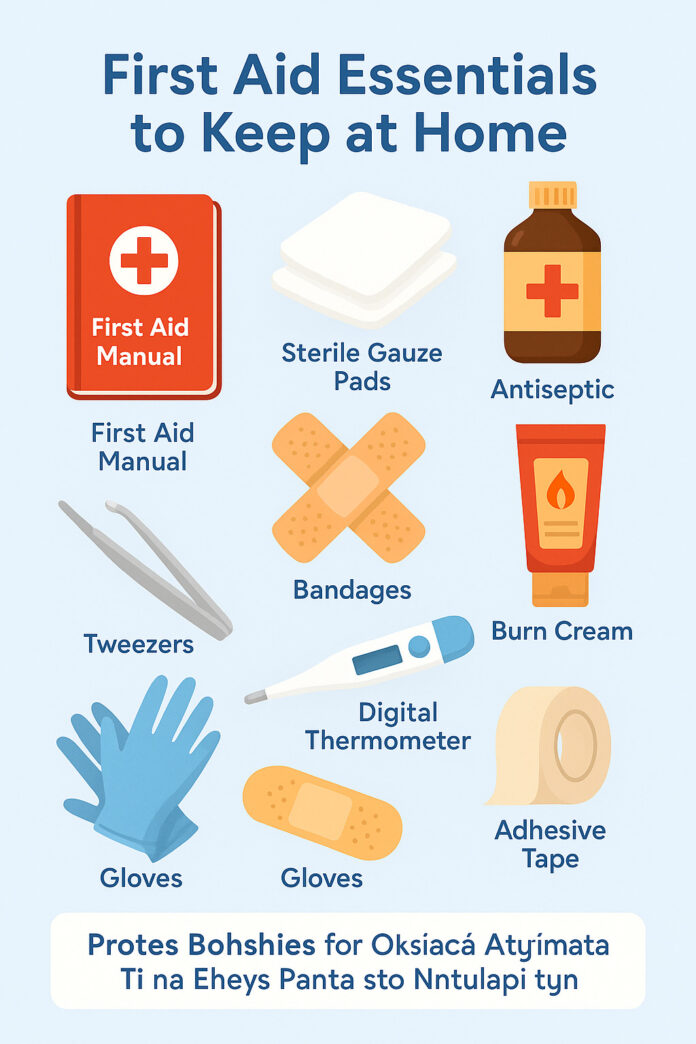Accidents can happen in the blink of an eye, even in the safest home. From minor burns in the kitchen to unexpected cuts or falls, being prepared is essential. A well-stocked first aid cabinet is your best defense for handling emergencies quickly and effectively.
In this guide, we’ll show you exactly what your home first aid kit should include, how to store it properly, and tips on how to handle common household incidents.
🧰 Why you need a first aid cabinet at home
Even small incidents can become serious without immediate care. A basic first aid kit gives you the tools you need to respond to injuries while waiting for professional help—or even avoiding a trip to the emergency room altogether.
🩺 Top 12 must-have items in your first aid cabinet

🧴 1. Antiseptic Wipes & Solution
Clean wounds quickly to avoid infections.
🩹 2. Sterile Bandages and Plasters
Keep a variety of sizes for small cuts, blisters, or grazes.
🩼 3. Gauze Pads & Medical Tape
Ideal for covering larger wounds or burns.
🔥 4. Burn Cream or Aloe Vera Gel
Soothes minor burns, especially kitchen-related injuries.
💊 5. Pain Relievers
Have paracetamol or ibuprofen available for headaches, fevers, or minor pain.
💉 6. Tweezers & Scissors
Useful for removing splinters or cutting gauze and tape.
💨 7. Cold Packs (Instant Ice Packs)
Reduces swelling from bumps, bruises, or sprains.
🧽 8. Disposable Gloves
Protect yourself and prevent contamination while treating others.
🌡️ 9. Thermometer
To check for fever during illness or infection.
💧 10. Saline Solution
Great for flushing eyes or cleaning wounds.
👃 11. Nasal Spray
For minor nosebleeds or blocked sinuses.
📖 12. First Aid Manual or Quick Guide
Helpful if you’re unsure how to respond to certain injuries.
🗂️ How to organize your first aid supplies

- Store everything in a clearly labeled box or container.
- Keep it in an easy-to-access spot, but out of reach of young children.
- Check expiration dates regularly and replace items when needed.
- Create separate mini-kits for the kitchen, car, or travel bag.
🛑 Common household accidents & what to do
🩸 Cuts & Scrapes
Wash with water and apply antiseptic. Cover with a clean bandage.
🔥 Burns
Cool with cold water for 10 minutes. Avoid ice. Apply burn cream and cover lightly.
🤕 Bumps & Bruises
Use a cold compress. Elevate if swollen.
🦶 Splinters
Remove gently with tweezers and clean area.
🤧 Allergic Reactions
Use antihistamines for mild cases. For serious symptoms, seek emergency help immediately.
💡 Pro Tips for home safety
- Teach every family member where the first aid kit is located.
- Learn basic CPR and first aid techniques.
- Add an emergency contact list inside the kit.
- Keep a flashlight nearby in case of power outages.
✅ Conclusion
Having a first aid cabinet at home isn’t just a recommendation—it’s a necessity. It helps you respond to minor injuries promptly and prepares you for unexpected emergencies. By keeping your supplies well-stocked and up to date, you’ll feel more secure knowing you can protect your family when it matters most.
Stay safe, stay prepared!



